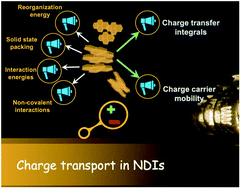Influence of non-covalent interactions in dictating the polarity and mobility of charge carriers in a series of crystalline NDIs: a computational case study†
Abstract
Polycyclic aromatic compounds and their derivatives have emerged as potential molecular entities for air-stable n-type organic semiconductors. In particular, naphthalene diimide (NDI)-derived compounds stand out as one of the most promising classes of molecules that have been studied extensively. There have been a lot of debatable experimental reports on the OFET performance characteristics of some of these materials, which have not yet been resolved completely. Hence, the critical intrinsic aspect of the molecular materials during charge transport in a bulk crystalline state would be essential to categorise the potential candidates. As a case study, in this comprehensive computational approach, we investigated the structural and supramolecular organization in single crystals and the role of those aspects in the bulk carrier transport of a group of selected end-substituted NDI derivatives. A subtle alteration of the end group was observed to result in the modulation of the polarity of charge transport and the charge carrier mobility in the single crystalline state. The disparity is addressed by considering the electronic coupling of the transport states, symmetry of the frontier molecular orbitals and various non-covalent intermolecular interactions. We expect that the present study would benefit towards the rational designing of air-stable n-type organic molecular semiconductors for efficient electronic devices.



 Please wait while we load your content...
Please wait while we load your content...